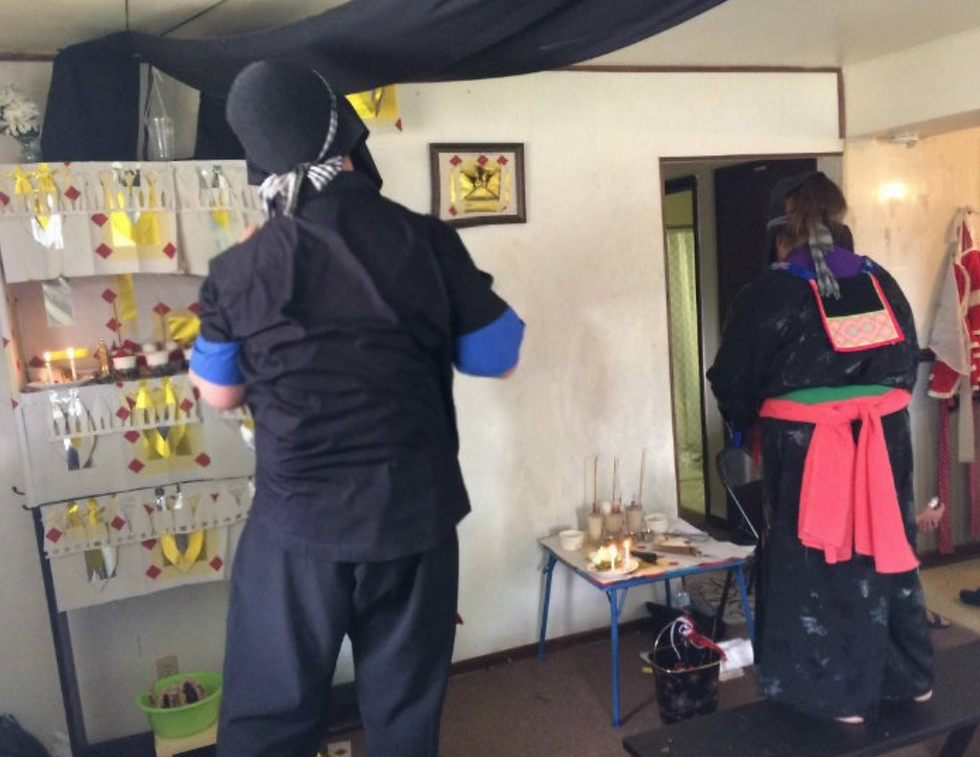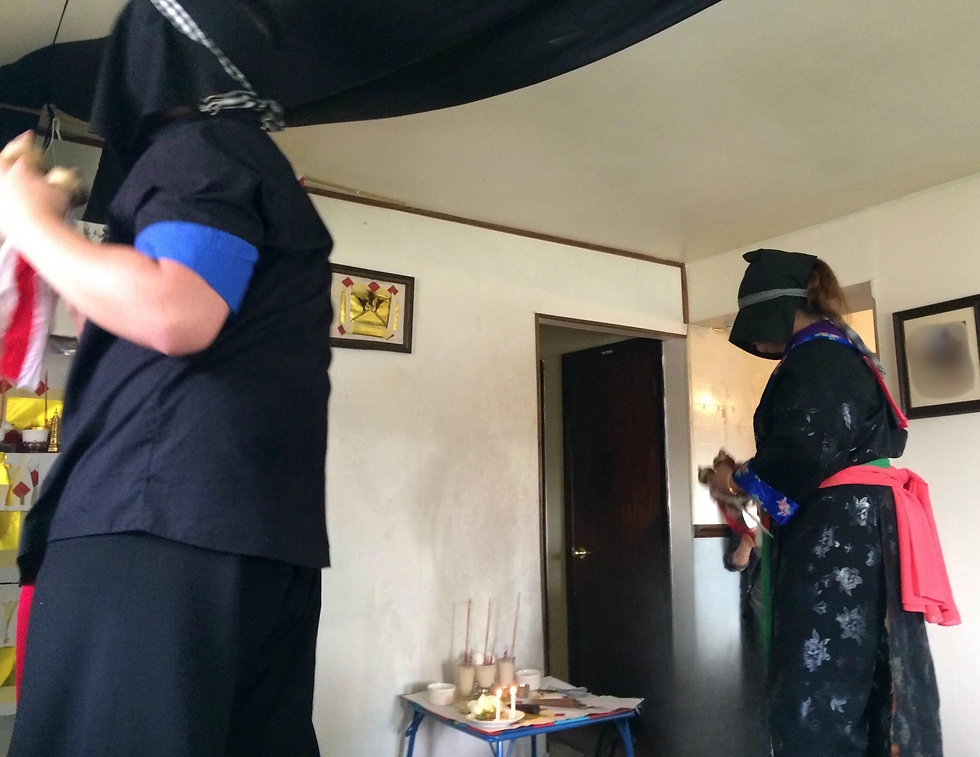Ua Neeb Tsa Thaj
- tflhmongshaman
- Aug 5
- 5 min read
In Hmong, "ua neeb" means shaman, "tsa" means to raise, and "thaj" means altar—together forming ua neeb tsa thaj, which translates to "raising the shaman altar." This ritual marks a significant milestone in a shaman apprentice’s journey, as it symbolizes a kind of spiritual "graduation." During the ceremony, a shaman master raises the apprentice’s large altar and establishes their choj neeb (spirit bridge), officially connecting it to the altar. In the apprentice’s home, this connection is often represented by black and/or white fabric draped from the top of the altar across the ceiling toward the front door. Some shamans use both colors, while others use just one. As seen in the photo below, I use a black cloth at the top. Then white cloth is expanded on the floor from the altar to the door. Additionally, yarn is strung across the ceiling along the same path, supported by three bamboo sticks, marking the completion of this sacred transition. The photo below depicts my ua neeb tsa thaj nearly a decade ago. My xib fwb is on the right and I am on the left.

During an ua neeb tsa thaj ceremony, both the shaman master and the apprentice enter trance together to spiritually journey through the ritual. Traditionally, a pig and a rooster are offered as sacrifices to support the raising and connection of the choj neeb—the shaman’s spirit bridge. As part of this sacred process, the apprentice must also perform a hu plig, or soul-calling ritual, to summon and raise their shaman spirits back home to the altar. This act calls their ancestral shaman spirits home to reside within and guard the newly raised altar.
But what actually happens during this ritual, and how is the altar raised? The details vary by lineage, as each shamanic tradition carries its own customs. In many lineages, the master and apprentice travel in trance to Yawm Laus Ntxoov Vaj Neeb—a spiritual realm understood to be where shamanic spirits and guides dwell, and where the choj neeb is anchored. This connection represents a direct spiritual link between the physical altar in the home and the world of the spirits. In my lineage, for example, we also journey to Tooj Nchaiv Siv Yis Neeb, Ntxoov Yaj Yuam, and Ntxoov Yaj Yig—realms where we cleanse our shamanic tools, sharpen our ritual knives and swords, and receive new ones. To access these sacred objects, we must prove ourselves as legitimate shamans. Without this recognition, we are not granted the tools or gifts of the spirits.
My tsa thaj took place nearly a decade ago, though it still feels like just yesterday. The journey since then has been long, humbling, and filled with growth—and I’m still learning every day. To those who are newly initiated, I offer this reflection and advice:
An expert often believes they know everything. Their cup is full. They walk into a room assuming they’re the most knowledgeable person there. But a beginner? A beginner’s mind is curious, open, and always listening. They don’t mind saying, “I’m not the smartest person in the room,” because they know that every person and every moment holds a lesson.
So my advice is this: always carry the mind of a beginner. That’s how we grow. That’s how we stay open to feedback, reflect, and refine our practice. Our experience is not the only experience. Our knowledge is limited by what we've been through; so be curious. Be open. And be cautious, too. It’s also important to develop your own system. Every shaman eventually finds their own rhythm and way of doing things. You might start by following your master’s methods, and that's a good foundation, but remember: you and your master are not the same person. You think differently. You interpret the spirit world through your own unique lens. So as you grow, figure out how you want to burn joss paper, how your assistant should support you, and what rituals feel aligned or need adapting. Find what works for you, and what doesn’t.

An ua neeb tsa thaj ceremony is not the end of anything. In truth, it’s just the beginning. It marks the very start of your shamanic journey, the tip of the iceberg. When we raise our altar, we are still beginners. We don’t yet know how to perform the complex rituals. And that’s okay. Take your time. Let yourself grow into your practice. Let the spirits guide you. Don’t rush to master everything all at once. In Hmong shamanism, there is no “number one.” There’s no GPA, no scorecard ranking who is most powerful or most advanced. So release the pressure to perform big rituals right away. You’re not supposed to know everything yet. You’re meant to grow into it, gradually, thoughtfully.
Think of it like learning to play a traditional instrument. We don't play the most complex songs the moment we first hold the instrument. At first, your fingers are awkward, your rhythm uncertain, and your breath unsteady. But with time, you begin to understand the sound, the pacing, the soul of the song. Eventually, the instrument doesn’t just respond to your hands, it sings with your spirit. That’s what it means to become a shaman. It’s not about how fast you can play. It’s about how deeply you learn to listen.
After my tsa thaj, there was a period when I threw myself completely into the work. I said yes to every request, every ritual, every ceremony. I thought that by constantly performing, constantly showing up, I was proving my worth as a shaman. I kept myself busy, thinking I had to earn my place in this spiritual world—and honestly, part of me just wanted to help everyone. But that pace caught up to me. I burned out. And yes, shamans can absolutely experience burnout. You’ll also encounter a wide range of people, some who admire your practice, and others who will question, compare, or criticize it. Everyone has an opinion, and that is their right. Some will say you’re doing it wrong. Some will say your way is too modern, too traditional, too soft, too intense. There will be whispers, doubts, and judgments. What I’ve learned is this: don’t let it shake you. Don’t let it poison your path. We went through a shaman experience that was painful, often terrifying initiation not by choice, but by calling. We didn’t ask for this. We survived it. And in many ways, it saved us. That alone is enough to keep moving forward. That alone is your truth.
You will also come across people with questionable intentions, those who may want to test you, manipulate you, or even practice black magic against you. I didn't believe this was even possible until I experienced it first hand. Black magic? I thought. But truth is, there truly are those who walk with love and those who walk with fear, control, and ego. You may feel spiritual attacks or be challenged by energies that don’t belong to you. If you stay firm in your practice, rooted in your truth, and grounded in light, you are protected. You don’t need to fight darkness with more darkness. You don’t need to prove your power. You only need to remain clear about who you are and why you do this work. Practice with integrity. Don’t dwell in revenge, fear, or power-seeking. You don’t have to show off your spirits or outshine others. Let your spirits speak through your humility, your boundaries, and your heart. As shamans, our purpose is simple but sacred: to serve. We are called to be healers and helpers, servants to our community, not masters over it. If our path begins to stray from service, if it becomes more about ego than care, then we must pause and ask ourselves if we are still walking in alignment with the spirits who chose us.
TFL Hmong Shaman

Comments